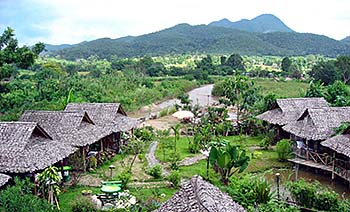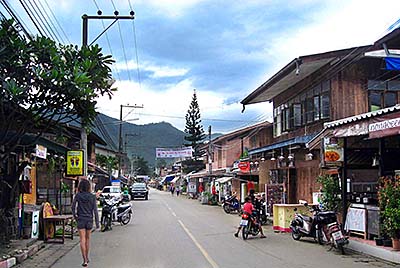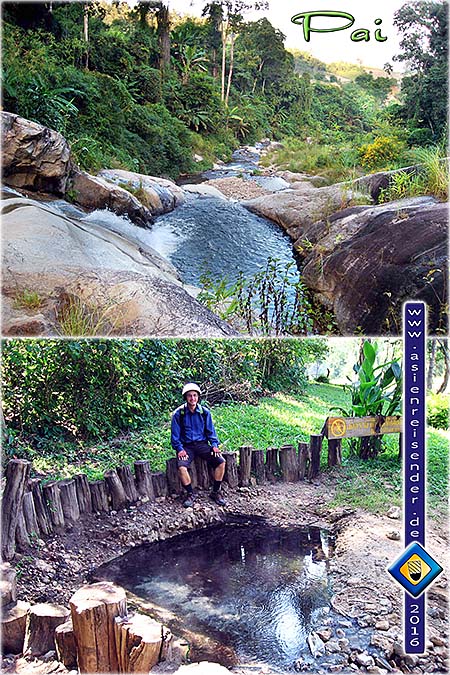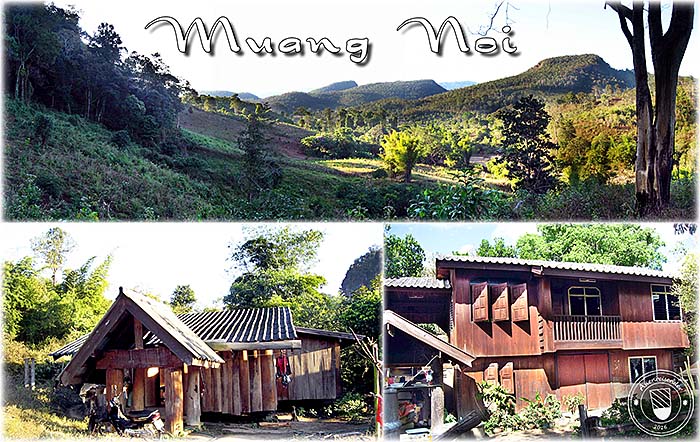1.
Pai
The small town of Pai lies in the very northwest of Thailand. Situated into a large valley at the banks of Pai River, the place was for most of it's history pretty cut-off from the centers of civilization. Pai's career as a major tourist destination begun in the 1960s and 1970s, when it became a stage on the 'hippie trail'. After the hippies came the backpackers and then more and more tourists of all kind. Now Pai is a stage on the 'banana pancake trail'.

The mountains north of Pai, seen from a resort at Pai River. Image by Asienreisender, 10/2010
Pai lies in Mae Hong Son Province, but is reachable best from Chiang Mai. The distance on serpentine road 1095 is about 145km. The road leads through mountainous terrain with widely green forests. Pretty picturesque landscapes, by the way. Pai Valley is no more far away from the Burmese border, but there is no major road going towards Burma.
Pai is, as most of the rural north of Thailand, tribal territory. In town one sees, particularly on market days when many people from the surroundings visit Pai for their businesses, many different, colourfully dressed people. There are Karen, Lisu, Hmong, Lahu and Shan people and many more. Some of them have merely a status as refugees and are no Thai nationals. A number of tribal villages are easily to reach by motorbike.

Pai Valley is surrounded by forested mountains. Verymost of the valley itself is coined by agriculture, most of it rice cultivation. In the mountains are many tribal villages and waterfalls. Here as everywhere in the mountains are seasonal permanent forest fires burning (arson), what has a heavy impact on the air quality. Image by Asienreisender, 10/2010
2.
Tourism

Inside Pai town, which has about 3,000 inhabitants. All the houses are low and still many wooden buildings are among them. Nowadays, due to real estate speculation and risen prices, the buildings get taller. Image by Asienreisender, 2010
Nowadays Pai has an increasingly booming tourist infrastructure. Land speculation went on already and the prices drove higher. The infrastructure is getting a major upgrade with an extention of the aiport capacity, more resorts, including some pretty pricy ones, more bars and clubs and a couple of 7-Eleven mini supermarkets. Traffic is boosting, noise pollution heavy, in peak season accommodation is running short and prices rise seasonally. Investment is coming not only from Thai businessmen from Chiang Mai or Bangkok, but also from Westerners who speculate on rising real-estate prices or business opportunities. Pai appeared in the last years in a TV serial and two movies what made Pai nationally famous in Thailand and attracts now groups of mostly young Thai tourists.

Sunrise over Pai. Rice production is much less profitable than tourism. These spots are desired for the erection of new bungalows, guesthouses, resorts etc, as to see left in the photo. New roads are built, more people enter the village, meanwhile it comes even to water and electicity shortages in peak season. Image by Asienreisender, 2/2007
3.
A Short History of Pai
A first recorded village named Ban Wiang Nuea was founded by Shan people in the mid 13th century three kilometers north of today's Pai. For a century or more the local people enjoyed the distance to and freedom from influences of any empire.

Thailand is rich in rivers and lakes, and there are always waterfalls in the mountains (here: Mo Paeng Watefall). Thai People have a strong affinity to waterfalls. Often turns out to be a series of rapids what is called a waterfall.
There are also several hot springs in Pai Valley, with their typical smell for sulfate. Images and photocomposition by Asienreisender, 11/2010, 2016
That changed in the 14th and 15th century, when the kingdom of Lanna stretched out it's areas of influence. Chiang Mai founded a new outpost in Pai Valley to safeguard the capital and to expand influence. This politics triggered a violent conflict with the Shan who got apparently support from other Shan in Burma. However, the struggle ended with the establishment of Lannanese rule over Pai Valley. The Shan people who inhabited the land before were subdued by Lanna, who ned urgently labour power to built up the place. Interestingly, the place became then divided between a town part of the old Shan population and another part of town for the incoming immigrants from Chiang Mai and other places in the north from where people were resettled to here.
It seems, the tensions between the two groups lasted centuries. Even as late as the mid 19th century Pai saw a conflict due to further immigration performed by the government in Chiang Mai. It came even to an open battle in 1869, in which the Shan were defeated and their village completely sacked and burnt down.
Over the centuries the road got little improvement and was still in the 20th century pretty poor. A trip from or to Chiang Mai lasted seven days with an oxcart and three or four days on an elephant.
In the Second World War, when Japanese troops operated on Thai ground to attack Britain in Burma and India, the Japanese army ned transport routes to the west. Additionally to the Death Railway in Kanchanaburi over the Three Pagodas Pass, they improved the road between Chiang Mai and Pai and further on the worse connection up to Mae Hong Son. After a military defeat in Burma in 1944, the Japanese gave the road project up.
It was continued then by the Thai government after the war. Also the road to Mae Hong Son became improvement in 1967, but no asphalt cover until the 1990s.

About 30km from Pai in the mountains close to the Burmese border lies the village of Muang Noi, a White Karen place. There are increadibly many different hill tribes living in these mountains, and all of them have significant different customs, means dress codes, foods, architectures. This kind of wooden houses is pretty unique. Images and photocomposition by Asienreisender, 1/2011, 2016